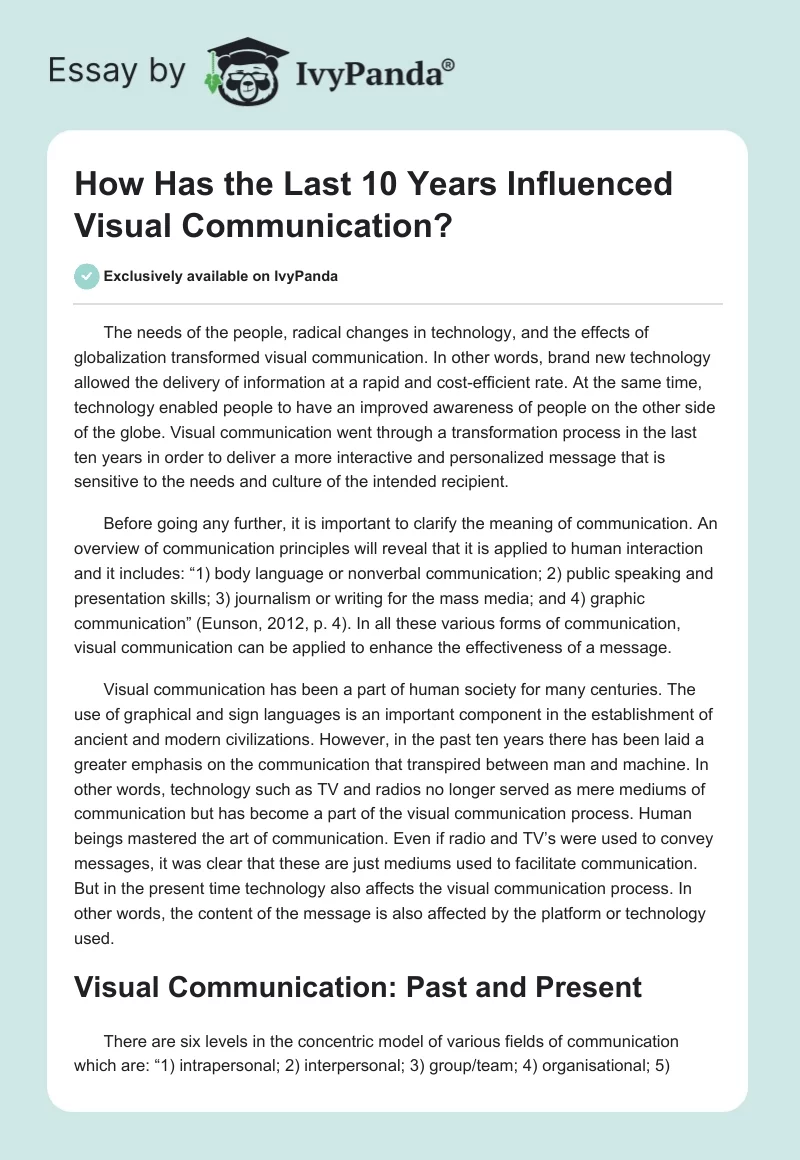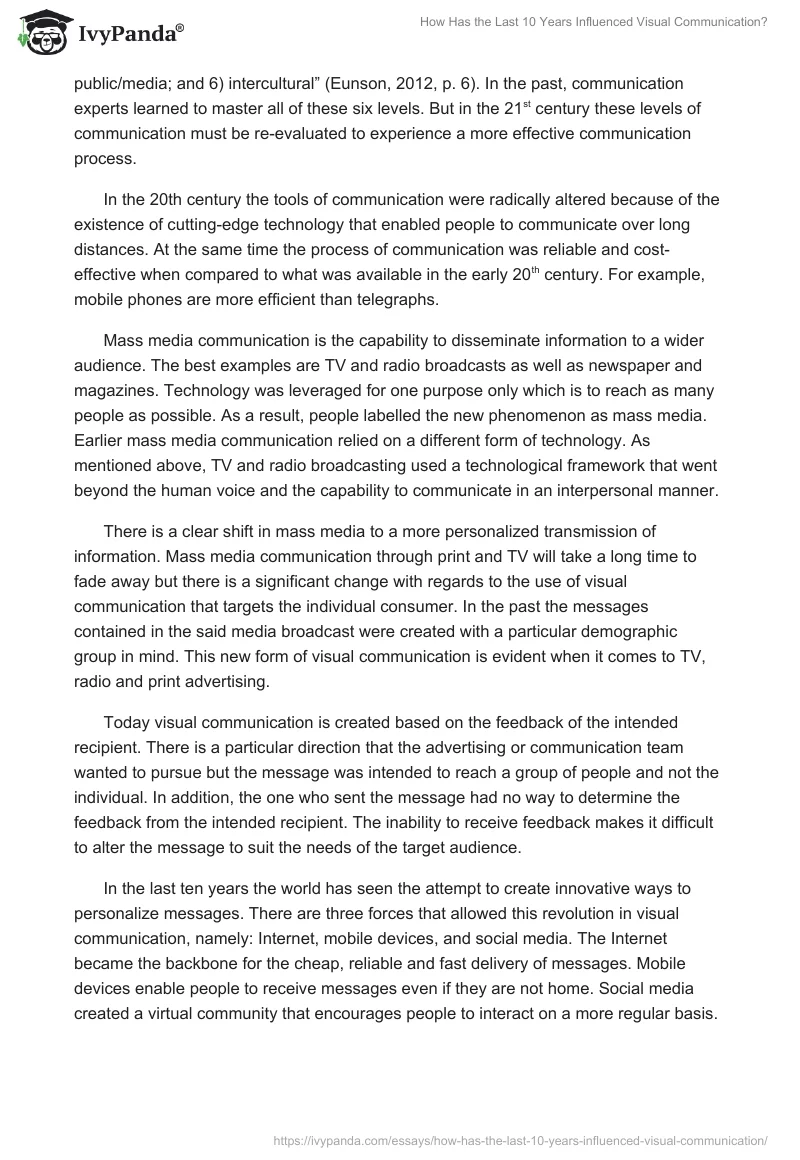The needs of the people, radical changes in technology, and the effects of globalization transformed visual communication. In other words, brand new technology allowed the delivery of information at a rapid and cost-efficient rate. At the same time, technology enabled people to have an improved awareness of people on the other side of the globe. Visual communication went through a transformation process in the last ten years in order to deliver a more interactive and personalized message that is sensitive to the needs and culture of the intended recipient.
Before going any further, it is important to clarify the meaning of communication. An overview of communication principles will reveal that it is applied to human interaction and it includes: “1) body language or nonverbal communication; 2) public speaking and presentation skills; 3) journalism or writing for the mass media; and 4) graphic communication” (Eunson, 2012, p. 4). In all these various forms of communication, visual communication can be applied to enhance the effectiveness of a message.
Visual communication has been a part of human society for many centuries. The use of graphical and sign languages is an important component in the establishment of ancient and modern civilizations. However, in the past ten years there has been laid a greater emphasis on the communication that transpired between man and machine. In other words, technology such as TV and radios no longer served as mere mediums of communication but has become a part of the visual communication process. Human beings mastered the art of communication. Even if radio and TV’s were used to convey messages, it was clear that these are just mediums used to facilitate communication. But in the present time technology also affects the visual communication process. In other words, the content of the message is also affected by the platform or technology used.
Visual Communication: Past and Present
There are six levels in the concentric model of various fields of communication which are: “1) intrapersonal; 2) interpersonal; 3) group/team; 4) organisational; 5) public/media; and 6) intercultural” (Eunson, 2012, p. 6). In the past, communication experts learned to master all of these six levels. But in the 21st century these levels of communication must be re-evaluated to experience a more effective communication process.
In the 20th century the tools of communication were radically altered because of the existence of cutting-edge technology that enabled people to communicate over long distances. At the same time the process of communication was reliable and cost-effective when compared to what was available in the early 20th century. For example, mobile phones are more efficient than telegraphs.
Mass media communication is the capability to disseminate information to a wider audience. The best examples are TV and radio broadcasts as well as newspaper and magazines. Technology was leveraged for one purpose only which is to reach as many people as possible. As a result, people labelled the new phenomenon as mass media. Earlier mass media communication relied on a different form of technology. As mentioned above, TV and radio broadcasting used a technological framework that went beyond the human voice and the capability to communicate in an interpersonal manner.
There is a clear shift in mass media to a more personalized transmission of information. Mass media communication through print and TV will take a long time to fade away but there is a significant change with regards to the use of visual communication that targets the individual consumer. In the past the messages contained in the said media broadcast were created with a particular demographic group in mind. This new form of visual communication is evident when it comes to TV, radio and print advertising.
Today visual communication is created based on the feedback of the intended recipient. There is a particular direction that the advertising or communication team wanted to pursue but the message was intended to reach a group of people and not the individual. In addition, the one who sent the message had no way to determine the feedback from the intended recipient. The inability to receive feedback makes it difficult to alter the message to suit the needs of the target audience.
In the last ten years the world has seen the attempt to create innovative ways to personalize messages. There are three forces that allowed this revolution in visual communication, namely: Internet, mobile devices, and social media. The Internet became the backbone for the cheap, reliable and fast delivery of messages. Mobile devices enable people to receive messages even if they are not home. Social media created a virtual community that encourages people to interact on a more regular basis.
At the same time social media such as social networking sites, have become sophisticated to the point that it can analyse and interpret the activities and personal interaction that occurred within their platform. In the case of Facebook and Google, the user activity and preferences can be analysed to reveal the needs of the person (Kirkpatrick, 2010). As a consequence a personalised message can be delivered to that person.
Aside from mobile gadgets linked to the Internet, there are other major means of transmitting graphical information to the target audience. According to one report:
We will certainly have near-eye displays with stunning capabilities weighing as little as ordinary eyeglasses … large flat screens will be prevalent unless they are abandoned for near-eye displays; projectors will be as ubiquitous and inexpensive as flashlights; printed displays with built-in printed batteries and electronics will be glued to a multitude of surfaces even on clothing (Hainich & Bimber, 2011, p. 505).
In the near future there will be a constant flow of visual information that can easily overwhelm the intended recipient of the message. Artists and creative minds will continue to contribute to the evolution of visual communication in the 21st century. But one of the most powerful influences will come from the business sector. Businessmen, in conjunction with advertising companies and marketers, will leverage digital technology to create visual images that are tailor-made to generate a personal response from the target market.
In the last few years, visual communication experts have seen the rise in the development of retail digital signage (Ryan & Conover, 2005). In the context of a store or a supermarket the customer will be made aware of digital signage place near the cashier or fitting room. These are places where customers are sometimes forced to stop and wait. In the past a digital signage can be compared to billboards. But the recent evolution of digital signage allows the delivery of personalized messages to the target market. In addition, a digital signage can be utilized to enable a more interactive way of communication.
The personalized communication process is made possible by other cutting-edge technology such as computer database and scanners. For example, a customer buys coffee, the cashier scans the bar code and the data filters through the database. Computer software initiates a process wherein the customer is offered a particular product that compliments the coffee. A digital signage placed near the cashier will be activated and a graphical interface will inform the customer that a particular brand of creamer is available at a discounted price.
Impact of Radical Changes in Visual Communication
The popularity of new technology can be explained in the context of cost-efficiency. According to one commentary, “Electronic displays might offer a higher information transport than print media, because displayed images can cognitively be read and interpreted more easily than abstract visuals, such as text” (Hainich & Bimber, 2011, p. 505).
The changes outlined above compel advertisers, creative agencies and communication experts to become more sensitive to the needs and feedback of the individual. However, there is greater need to be more sensitive to the cultural implication of a particular message. Furthermore, the shift from abstract to graphic messages necessitates an overhaul of the communication process. In the past print media combined the power of words and images. But in a fast moving world of the 21st century, young people have shorter attention spans, and, consequently, there is no choice but to create a message that is more graphic in nature.
One of the end-results of the excessive use of graphics is to force people to understand images with little supporting information that can be gleaned from an accompanying text message. The heavy emphasis on visual images with abstract information was succinctly described by analysts who said, “because we are bombarded with messages daily, we have become jaded and very selective about what we read or process” (Ryan & Conover, 2005, p.1). It is, therefore, important to take a closer look at the way visual communication was utilized in order to improve its intended effect on the target audience.
According to experts in the field of visual communication, a better way to utilize visual communication is to realize that people are the goal and not the means. Visual communication focuses on themes of great relevance such as migration, socialization of minorities, integration, urban trends and many more (Bevolo, 2010). Aside from businessmen, communication experts are aware that in order to develop messages that are well received by the intended audience, there is a need to incorporate these social issues into their message. But communication agencies in public and private sector must also utilise this insight to develop messages that are lucid and direct to the point. The short attention span of their intended recipient may prevent the effective transmission of ideas.
Another significant development in visual communication is in the importance of culture. In a globalized world, visual communication experts must be sensitive to the differences in culture across different societies. Therefore, it is not enough to create a generic message and expect to have interaction with the target market or intended recipient of the message.
Finally, there is a shift from creating neutral messages intended for the general public. According to the report, there is now a realization that it is not enough to simply create a product but it is also critical to generate stories “and a narrative line that boldly tells the rest of the world who you are” (Bevolo, 2010, p. 203). The availability of technology that enables rapid and efficient communication strengthens this argument.
Conclusion
Visual communication was transformed by the need for a more personalized way to communicate to individuals. Aside from the need to create an interactive way to communicate with the intended audience, marketing experts, businessmen and communication experts realised the need for greater sensitivity to people’s needs and culture. Cutting-edge technology enables faster and more reliable transmission of visual information all over the world. Therefore, there is a need to take into consideration the feelings and ideologies of people from different cultures. This realization must be in the forefront even as computers, social networking sites and mobile gadgets significantly altered the way people create and deliver graphical messages. Due to this realization advertising companies, public relations firms, and communication strategies will pay more attention to the type of visual communication they will create.
References
Bevolo, M. (2010). The golden crossroads. New York: Palgrave Macmillan.
Eunson, B. (2012). Communicating in the 21st century. UK: John Wiley & Sons.
Hainich, R. & Bimber, O. (2011). Displays: fundamentals and applications. New Jersey: Taylor & Francis Group.
Kirkpatrick, D. (2010). The Facebook effect. New York: Simon & Schuster.
Ryan, W. & Conover, T. (2005). Graphic communications today. OH: Cengage Learning.


